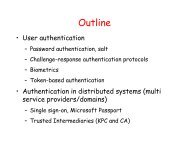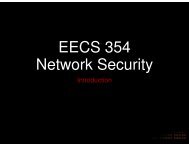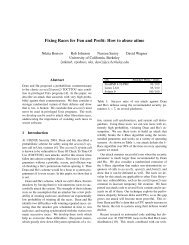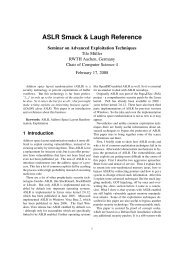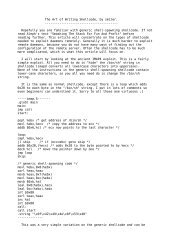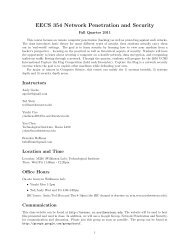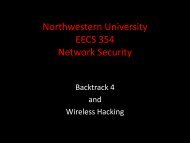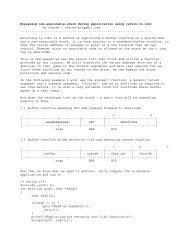Advanced Return to libc Exploits
Advanced Return to libc Exploits
Advanced Return to libc Exploits
Create successful ePaper yourself
Turn your PDF publications into a flip-book with our unique Google optimized e-Paper software.
attacker has a fair chance of guessing right. Sure, each failed attempt is<br />
logged, but even large amount of logs at 2 am prevent nothing :) Solution:<br />
deploy segvguard [8]. It is a daemon which is notified by the kernel each<br />
time a process crashes with SIGSEGV or similar. Segvguard is able <strong>to</strong><br />
temporarily disable execution of programs (which prevents bruteforcing),<br />
and has a few interesting features more. It is worth <strong>to</strong> use it even without<br />
PaX.<br />
3) The information on the library and stack addresses can leak due <strong>to</strong><br />
format bugs. For example, in case of wuftpd vulnerability, one could explore<br />
the stack with the command<br />
site exec [eat stack]%x.%x.%x...<br />
The au<strong>to</strong>matic variables' pointers buried in the stack will reveal the stack<br />
base. The dynamic linker and <strong>libc</strong> startup routines leave on the stack some<br />
pointers (and return addresses) <strong>to</strong> the library objects, so it is possible<br />
<strong>to</strong> deduce the libraries base as well.<br />
4) Sometimes, one can find a suitable function in an attacked binary<br />
(which is not position-independent and can't be mmapped randomly). For<br />
example, "su" has a function (called after successful authentication) which<br />
acquires root privileges and executes a shell - nothing more is needed.<br />
5) All library functions used by a vulnerable program can be called<br />
via their PLT entry. Just like the binary, PLT must be present at a fixed<br />
address. Vulnerable programs are usually large and call many functions, so<br />
there is some probability of finding interesting stuff in PLT.<br />
In fact only the last three problems cannot be fixed, and none of<br />
them is guaranteed <strong>to</strong> manifest in a manner allowing successful exploitation<br />
(the fourth is very rare). We certainly need more generic methods.<br />
In the following chapter I will describe the interface <strong>to</strong> the dynamic<br />
linker's dl-resolve() function. If it is passed appropriate arguments, one<br />
of them being an asciiz string holding a function name, it will determine<br />
the actual function address. This functionality is similar <strong>to</strong> dlsym()<br />
function. Using the dl-resolve() function, we are able <strong>to</strong> build a<br />
return-in<strong>to</strong>-lib exploit, which will return in<strong>to</strong> a function, whose address<br />
is not known at exploit's build time. [12] also describes a method of<br />
acquiring a function address by its name, but the presented technique is<br />
useless for our purposes.<br />
--[ 5 - The dynamic linker's dl-resolve() function<br />
This chapter is simplified as much as possible. For the<br />
detailed description, see [9] and g<strong>libc</strong> sources, especially the file<br />
dl-runtime.c. See also [12].<br />
----[ 5.1 - A few ELF data types<br />
The following definitions are taken from the include file elf.h:<br />
typedef uint32_t Elf32_Addr;<br />
typedef uint32_t Elf32_Word;<br />
typedef struct<br />
{




